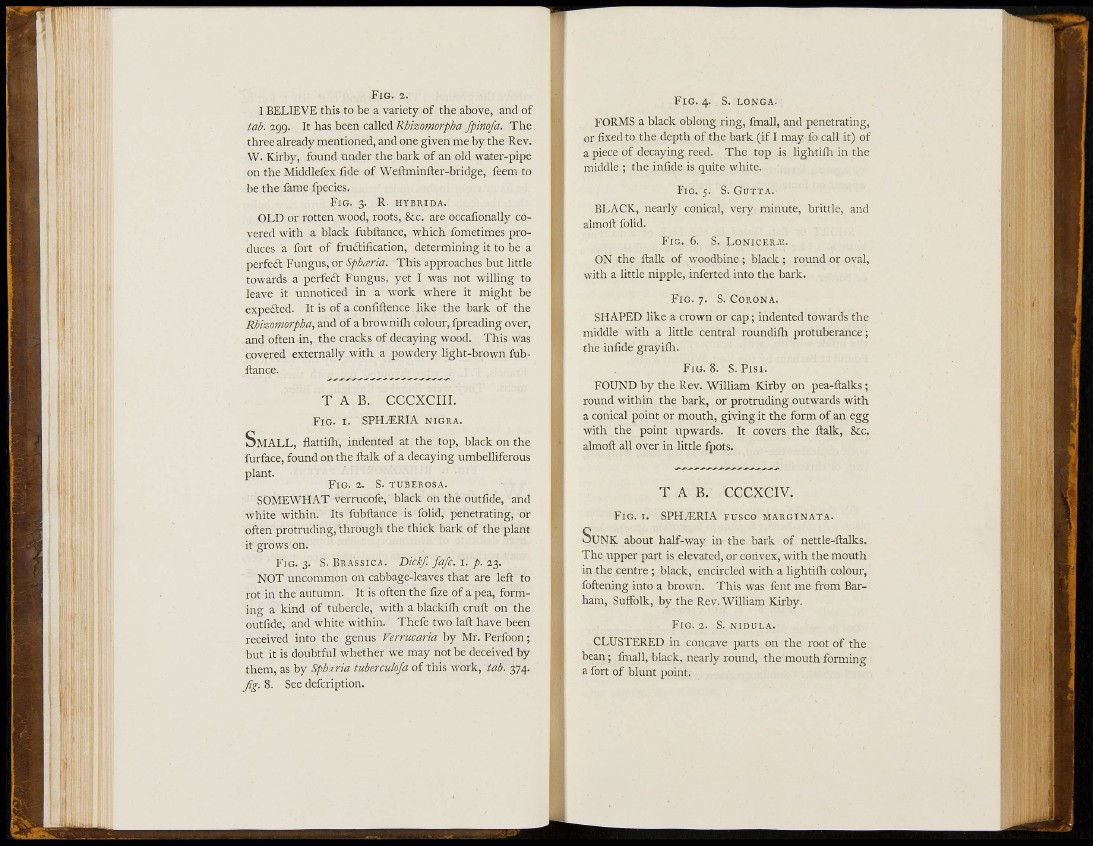
F I G . A.
I BELIEVE this to be a variety of the above, and of
tab. 299. It has been called Rhizomorpha Jpinofa. The
three already mentioned, and one given me by the Rev.
W. Kirby, found under the bark of an old water-pipe
on the Middlefex fide of Weftminfter-bridge, feem to
be the fame fpecies.
FIG. 3. R- HYBRIDA.
OLD or rotten wood, roots, &c. are occafionally covered
with a black fubftance, which Ibmetimes produces
a fort of fructification, determining it to be a
perfe6t Fungus, or Spbaria. This approaches but little
towards a perfeit Fungus, yet I was not willing to
leave it unnoticed in a work where it might be
expefted. It is of a confiftence like the bark of the
Rhizomorpha, and of a brownifli colour, fpreading over,
. and often in, the cracks of decaying wood. This was
covered externally with a powdery light-brown fubftance.
T A B . CCCXCIII.
FIG. I. SPHIERLA NIGRA.
SMALL, flattiilr, indented at the top, black on the
furface, found on the ftalk of a decaying umbeUiferous
plant.
FIG. a. S. TUBEROSA.
SOMEWHAT verrucofe, black on the outfide, and
white within. Its fubftance is folid, penetrating, or
often protruding, through the thick bark of the plant
it grows on.
FIG. 3. S. BRASSICA. Diet/, fafc. i. p. 23.
NOT uncommon on cabbage-leaves that are left to
rot in the autumn. It is often the fize of a pea, forming
a kind of tubercle, with a blackifli cruft on the
outfide, and white within. Thefe two laft have been
received into the genus Verrucaria by Mr. Perfoon;
but it is doubtful whether we may not be deceived by
them, as by Spbaria tuberculofa of this work, toi. 374.
Jig. 8. See defcription.
F I G . 4. S. LONGA.
FORMS a black oblong ring, fmall, and penetrating,
or fixed to the depth of the bark (if I may fo call it) of
a piece of decaying reed. The top is lightifli in the
middle ; the infide is quite white.
FIG. 5. S. GUTTA.
BLACK, nearly conical, very minute, brittle, and
almoft folid.
FIG. 6. S. LONICER.«.
ON the ftalk of woodbine; black ; round or oval,
with a little nipple, inferted into the bark.
F I G . 7. S. CORONA.
SHAPED like a crown or cap; indented towards the
middle with a little central roundifh protuberance;
the infide grayifli.
FIG. 8. S. Pisi.
FOUND by the Rev. William Kirby on pea-ftalks ;
round within the bark, or protruding outwards with
a conical point or mouth, giving it the form of an egg
with the point upwards. It covers the ftalk, &c.
almoft all over in little fpots.
T A B . CCCXCIV.
F I G . I. SPHJERIA FUSCO MARGINATA.
SUNK about half-way in the bark of nettle-ftalks.
The upper part is elevated, or convex, with the mouth
in the centre ; black, encircled with a lightifli colour,
foftening into a brown. This was fent me from Barham,
Suffolk, by the Rev. William Kirby.
FIG. 2. S. NIDULA.
CLUSTERED in concave parts on the root of the
bean; fmall, black, nearly round, the mouth forming
a fort of blunt point.